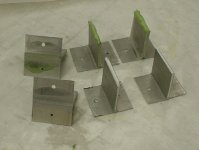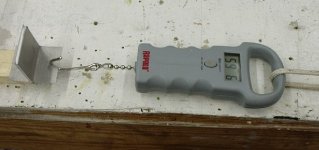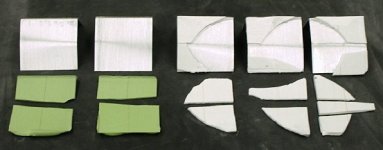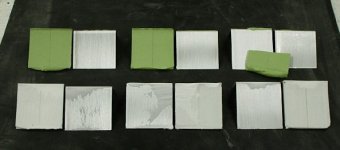Did a simple experiment to compare the peel strength of Evercoat Rage Gold (polyester) to West (epoxy) and micro when applied to aluminum.
Prepared six coupon sets by sanding a strip of alclad 2024 with 120 grit and shearing it into 12 pieces 3" long x 2" wide. Each went in the brake and 1" was bent 90 degrees. The all coupons were cleaned with wet MEK and new rags. Three sets were bonded using Rage Gold, and three were bonded using dry micro. All were a simple sandwich; blob on filler, apply the other coupon, and squeeze until filler extruded out all sides with about 1/8" in the sandwich. After 24 hours to cure, the flat bottoms were sanded to eliminate excess filler along the bond line.
The test fixture was not exotic; a screw in the benchtop and my trusty electronic fish scale.
The first polyester coupon pegged the scale at 75 lbs without separating. The second failed at less than 10 lbs. The third again pegged the scale.
All three epoxy coupons pegged the scale at 75 lbs.
Ok, next test was to clamp one leg of each coupon in the bench vice and pull the other at an angle of about 10 degrees, which increased the peel force by flexing the aluminum "handles". Both remaining polyester coupons failed at low values with a slight "pop". All the epoxy coupons again pegged the scale.
I finally broke all three epoxy coupons by grabbing the free leg with a pair of vicegrips and jerking them as hard as I could (I'm 6-2 and 210 lbs). All required repeated attempts and the last one nearly whipped me.
All the polyester coupons failed by peeling cleanly from the aluminum surface. With just a little work the filler could be popped off the other surface (on right).
The dry micro failed by first fracturing through the micro/epoxy, then peeling as the aluminum bent away.
In simple terms, the adhesion of a dry epoxy/micro mix was much superior to the Rage Gold polyester filler. For all the epoxy samples, failures didn't happen until I exceeded the tensile strength of the micro. Only then did they peel, and the peel wasn't necessarily clean in nature. One polyester sample failed by peel at a very low value in a straight pull, and the others peeled immediately when subjected to a slight flex of the aluminum tab.
I suspect one significant factor is the fast cure time of Rage vs the opportunity for surface wetting during the slow cure time for epoxy.
It ain't formal test lab stuff, but I think I'll stick with dry micro.
Sorry, couldn't resist the pun <g>
Prepared six coupon sets by sanding a strip of alclad 2024 with 120 grit and shearing it into 12 pieces 3" long x 2" wide. Each went in the brake and 1" was bent 90 degrees. The all coupons were cleaned with wet MEK and new rags. Three sets were bonded using Rage Gold, and three were bonded using dry micro. All were a simple sandwich; blob on filler, apply the other coupon, and squeeze until filler extruded out all sides with about 1/8" in the sandwich. After 24 hours to cure, the flat bottoms were sanded to eliminate excess filler along the bond line.
The test fixture was not exotic; a screw in the benchtop and my trusty electronic fish scale.
The first polyester coupon pegged the scale at 75 lbs without separating. The second failed at less than 10 lbs. The third again pegged the scale.
All three epoxy coupons pegged the scale at 75 lbs.
Ok, next test was to clamp one leg of each coupon in the bench vice and pull the other at an angle of about 10 degrees, which increased the peel force by flexing the aluminum "handles". Both remaining polyester coupons failed at low values with a slight "pop". All the epoxy coupons again pegged the scale.
I finally broke all three epoxy coupons by grabbing the free leg with a pair of vicegrips and jerking them as hard as I could (I'm 6-2 and 210 lbs). All required repeated attempts and the last one nearly whipped me.
All the polyester coupons failed by peeling cleanly from the aluminum surface. With just a little work the filler could be popped off the other surface (on right).
The dry micro failed by first fracturing through the micro/epoxy, then peeling as the aluminum bent away.
In simple terms, the adhesion of a dry epoxy/micro mix was much superior to the Rage Gold polyester filler. For all the epoxy samples, failures didn't happen until I exceeded the tensile strength of the micro. Only then did they peel, and the peel wasn't necessarily clean in nature. One polyester sample failed by peel at a very low value in a straight pull, and the others peeled immediately when subjected to a slight flex of the aluminum tab.
I suspect one significant factor is the fast cure time of Rage vs the opportunity for surface wetting during the slow cure time for epoxy.
It ain't formal test lab stuff, but I think I'll stick with dry micro.
Sorry, couldn't resist the pun <g>
Attachments
Last edited:










